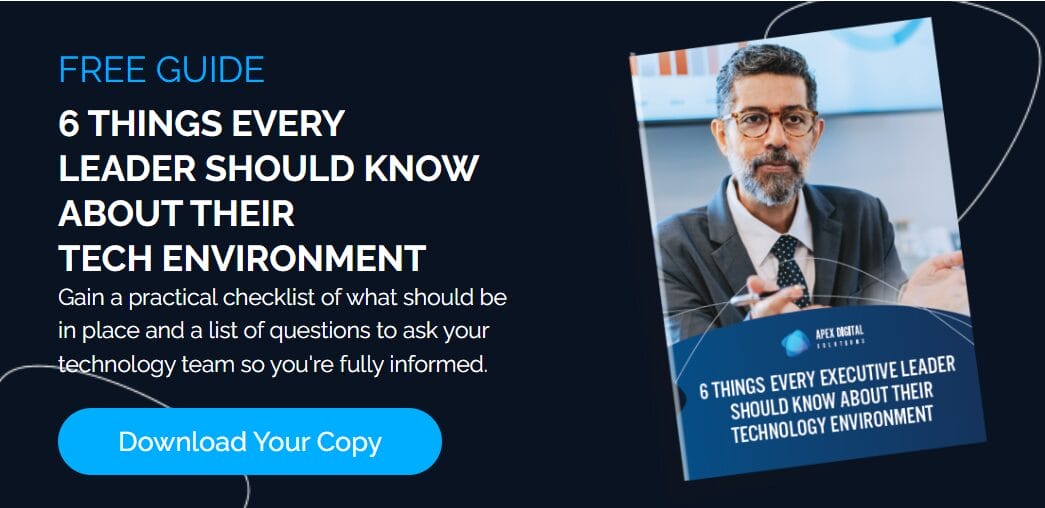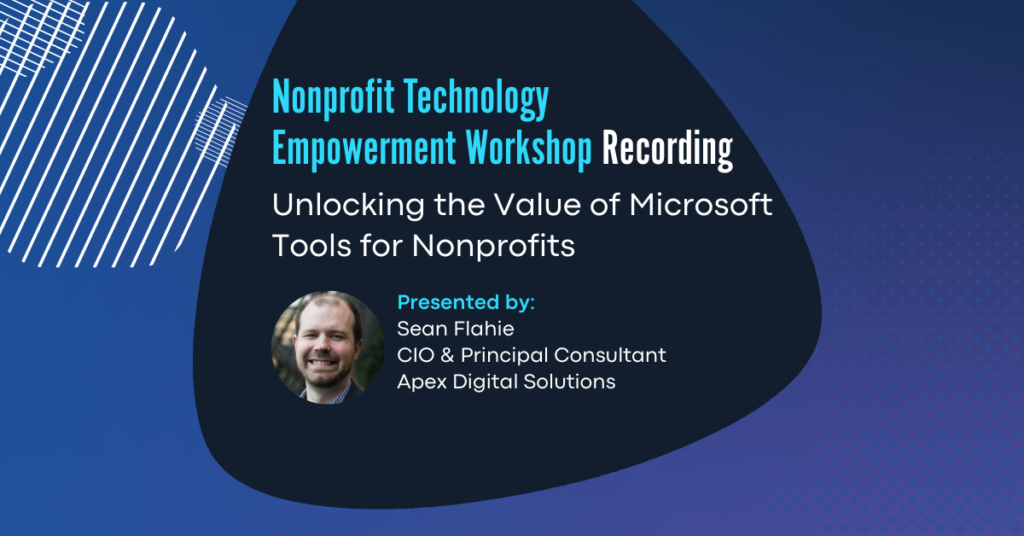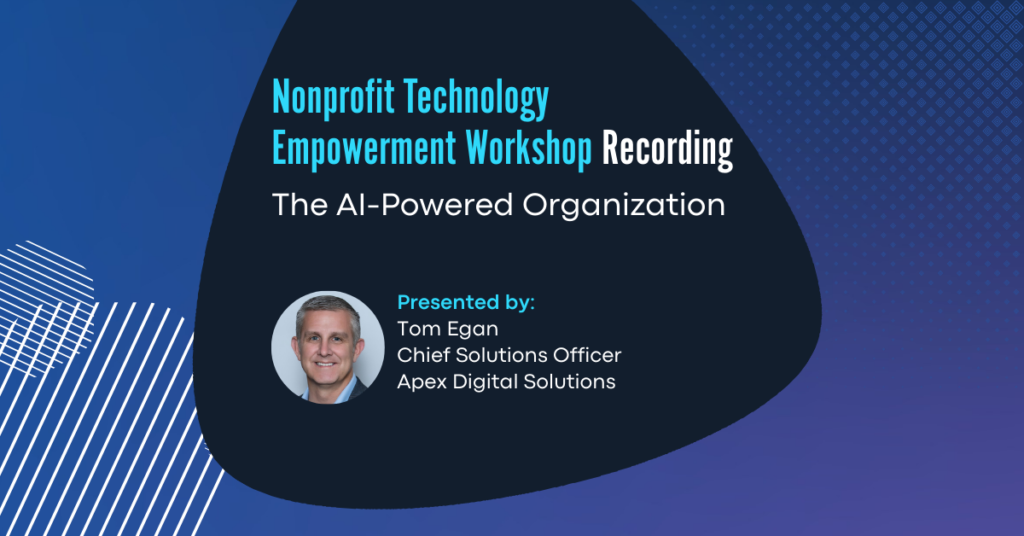Nonprofit technology is changing fast. Organizations are being asked to serve more people with fewer resources while cyber risk rises and digital expectations climb. The priority is clear: get more from your existing tools, strengthen security and governance, improve collaboration and data access, and prepare your team to use AI responsibly.
Below, watch a full presentation and fireside chat featuring Sue McGuire of United Way for Southeastern Michigan, Sireesha Mandava of GreenPath Financial Wellness, and Sean Flahie of Apex Digital, moderated by Jason Lambiris. The discussion surfaces today’s biggest challenges and gives practical moves you can use now to clarify priorities, reduce risk, and unlock capacity across your programs.
Nonprofit sector by the numbers
These numbers indicate how essential the nonprofit sector is to communities and the economy. At this scale, technology is not a back-office expense. It is the infrastructure that keeps programs running, protects sensitive data, and lets small teams do the work of much larger ones through cloud services, collaboration tools, strong security, and AI.
10 million+
Currently active nonprofits
across the globe
12.8 million
Nonprofit employees in the U.S.
(~ 10% of the private workforce)
75 million
Americans volunteered
at nonprofits
in the last year
~$2.6 trillion
contributed by U.S. nonprofits
to the economy ($~5-6% of GDP)
Rising pressures nonprofits are managing
Nonprofits are being asked to do more with less. The demand for services is increasing, but resources are shrinking and staff are stretched thin. Inflation, financial instability, and operational inefficiencies add to the pressure. Technology gaps and limited data capacity make it even harder to keep up.
Funding and resource strain
Tight budgets and rising costs. 58% of nonprofit leaders cite competition for funding as a top challenge and 70% expect no increase in foundation grants this year.
Workforce and burnout
Talent shortages are widespread. Over half of nonprofits struggle to attract and retain staff, and nearly 90% of nonprofit leaders are concerned about burnout.
Operational gaps
Many organizations report limited real-time data and low process automation. Manual paperwork and siloed data slow service delivery.

Opportunities for Nonprofits in a Digital Future
While nonprofits face increasing pressures, there are also clear opportunities to strengthen impact through technology and people-centered strategies. By focusing on a few key areas, organizations can turn today’s challenges into long-term progress.
Digital Transformation
Nonprofits have the chance to operate smarter by embracing cloud platforms like Microsoft 365, collaboration tools, and automation. These technologies reduce costs and free up staff time, allowing organizations to focus on mission-driven work rather than manual processes.
Data and AI for Impact
Program and donor data becomes more valuable when paired with Microsoft Power BI and Dynamics 365. These platforms help organizations analyze trends, personalize outreach, and make informed decisions. AI, through Microsoft Copilot and Azure AI services, is beginning to reshape nonprofit operations. Yet only 41% of nonprofit leaders feel confident using AI today, making data literacy and trusted guidance essential.
Expanding Reach Online
Digital engagement and virtual service delivery are no longer optional. With Microsoft Teams, nonprofits can engage supporters, volunteers, and donors across geographies. Virtual delivery and digital campaigns enable outreach well beyond a local base, including international audiences. This shift creates opportunities to connect with people who may never set foot in the organization’s local offices but want to support its mission.
People Development
Technology investments are only successful when staff feel equipped to use them. Investing in people ensures long-term success. Upskilling staff, providing ongoing training, and building a culture of digital literacy turn technology change into sustainable momentum. Teams that feel confident in their digital skills are better positioned to innovate and adapt.
Watch other sessions from the Nonprofit Technology Workshop:
Unlocking the Value of Microsoft Tools for Nonprofits
Learn how to stretch nonprofit licensing, uncover underused features in Microsoft 365, and apply practical steps that boost collaboration and security.

The AI-Powered Organization
See how AI and Microsoft Copilot can streamline daily work and program delivery, plus what foundations you need for safe, effective adoption.

Practical Technology Lessons for Nonprofits
- Maximize what you already own. Many nonprofits pay for Microsoft 365 but underuse its features, leading to inefficiency and duplicate tools. Microsoft 365 and Microsoft Teams offer co-authoring, shared workspaces, and mobile access that cut down on version chaos, reduce costs, and speed up collaboration.
- Build digital literacy continuously. New tools often fail without proper adoption. Regular training, like lunch-and-learns or role-based sessions, helps staff, boards, and volunteers adopt tools with confidence and consistency.
- Security is ongoing work. Many organizations think of security as a project with an end date, but the threat landscape keeps evolving. People remain the biggest risk factor. Annual must-pass training, phishing simulations, and disciplined inventory of devices and accounts create stronger defenses.
- Frame security as risk management. Security investments often stall when they are presented as technical expenses. Boards and leaders respond when security investments are tied to protecting reputation, donor trust, and service continuity.
- Lay foundations for AI. The promise of AI excites many nonprofits, but rushing in without proper preparation can create risk. Governance, data protections, and clear policy must come first. Start small with Microsoft Copilot pilots in areas like meeting notes or analysis, then expand. Get the guide on Microsoft Copilot readiness >>
- Treat change management as core work. Technology projects are most likely to fail when people are left behind. Stakeholder alignment, phased rollouts, and open feedback loops are critical for complex technology projects such as CRM transitions.
Want to dive deeper? Explore the other recorded sessions above, or contact us to start a conversation about your organization’s next steps.


